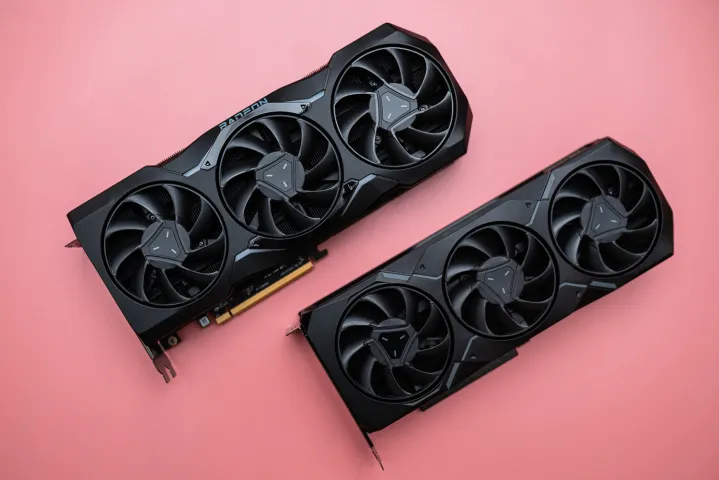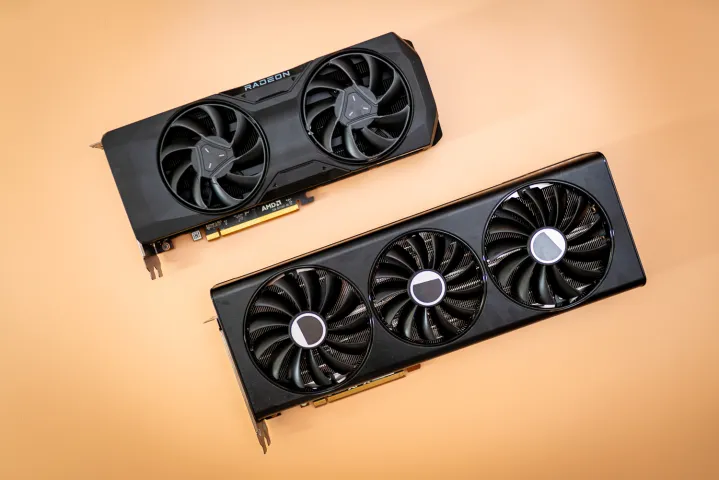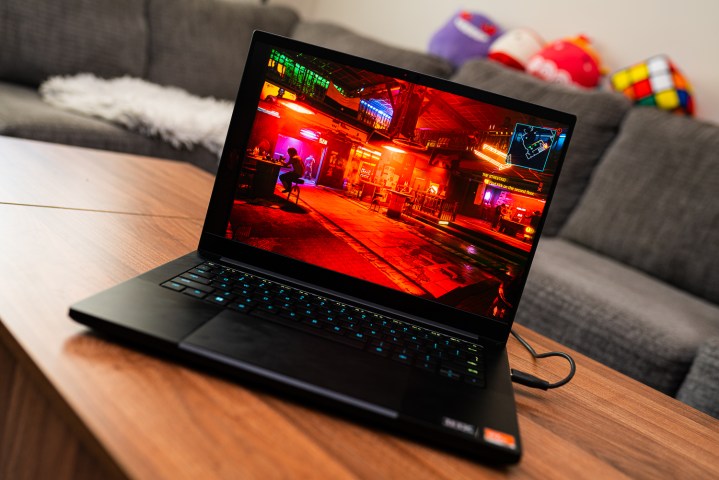
With the demands of modern PC games, no less than one of the best graphics cards will do, preferably in partnership with one of the best processors . We've reviewed dozens of GPUs and spent over 200 hours benchmarking them, and these are the cards that we've tested and can still swear by despite the current state of the GPU market.
Graphics cards are not cheap right now, but the models listed below remain competitive. Some are pricier than they were at launch, but we hand-picked the ones that are still readily available and worth your money. With Nvidia's RTX 50-series , AMD's RDNA 4 , and Intel's Arc Battlemage out in full swing, we're spoiled for choice, and it's all a matter of hunting down a good deal selling close to the recommended list price (MSRP).
These are the graphics cards I recommend today, based on hours of in-house testing.

The most powerful graphics card
Nvidia GeForce RTX 5090
- Unrivaled 4K gaming performance
- Innovative, attractive Founder's Edition design
- DisplayPort 2.1 and 4:2:2 encoding
- 32GB of memory for AI workloads
- DLSS 4 is a treat...
- ...when it works properly
- Insanely expensive
- Power requirements are off the charts
| Specification: | |
| VRAM | 32GB GDDR7 |
| Power requirements | 575 watts |
| Architecture | Blackwell |
Why should you buy this: It's the most powerful graphics card money can buy.
Who's it for: Enthusiasts who don't mind spending up for the best of the best.
What we thought of the Nvidia GeForce RTX 5090:
The RTX 5090 is the most ridiculous graphics card Nvidia has ever released. I'm still shocked by its performance. At 4K, I measured frame rates that are on average 30% higher than the RTX 4090, and that's before you factor in the new DLSS Multi-Frame Generation feature that's available on Nvidia's RTX 50-series graphics cards.
Although Nvidia takes the crown in gaming, the RTX 5090 is suited for a ton of other workloads, too. With 32GB of GDDR7 memory, it allows you to dip your toe into training AI language models, and with DisplayPort 2.1 and 4:2:2 encoding, it's a great option for media production. For me, it's the design that stands out most, however. Nvidia developer a flow-through design for its Founder's Edition model, allowing the company to shrink this graphics card down to only two slots.
This is all great, but the RTX 5090 also comes in at $2,000 to start with, and it hardly ever sells for less than $2,800. Some models go over $4,000. It's the most expensive graphics card Nvidia has ever released, and for most people, it's just too expensive. If you want the best of the best, though, Nvidia is delivering it with the RTX 5090.

The best value graphics card
Intel Arc B580
- Lower price than AMD and Nvidia alternatives
- 12GB of VRAM
- XeSS 2 support
- Incredible performance for the price
- Occasional driver issues
- 190W is a lot for a budget GPU
| Specification: | |
| VRAM | 12GB GDDR6 |
| Power requirements | 190 watts |
| Architecture | Battlemage |
Why should you buy this: It's a powerful graphics card that has no business being as inexpensive as it is.
Who's it for: Gamers who want solid performance under $280.
What we thought of the Intel Arc B580:
I'm shocked the Arc B580 is as good as it is. It comes in at $250, but is usually sold at a higher price, hovering around $280. One way or another, it has no business being that inexpensive. Based on my testing, it's a clean 9% faster than Nvidia's RTX 4060 at 1080p, and a massive 18% faster at 1440p. This is a graphics card that not only goes toe-to-toe with Nvidia and AMD on performance. It also comes in at a much cheaper price.
To me, the Arc B580 feels like a course correction. The market for $250 graphics cards has been woefully underserved for the past few years, but Intel is delivering a GPU with the Arc B580 in that price bracket that's compelling. It's a solid performer, but more than that, it's a capable modern GPU with good ray tracing performance, 12GB of VRAM, and even frame generation support with XeSS 2.
Intel's discrete graphics business is still fairly young, but if I was building a budget PC today, it'd be hard to argue with what the Arc B580 offers. It's capable of just about anything at 1080p, and based on my testing, it even has enough grunt to go up to 1440p. The fact that it's actually cheaper than the competition is just the cherry on top.

The best graphics card for gaming
Nvidia GeForce RTX 4070 Super
- Solid performance improvement over RTX 4070
- Still highly efficient
- DLSS 3.5
- Fantastic ray tracing performance
- Great value
- Only minor uplifts in a few games
- 12GB of VRAM may limit some ray-traced titles at 4K
| Specification: | |
| VRAM | 12GB GDDR6X |
| Power requirements | 200 watts |
| Architecture | Ada Lovelace |
Why should you buy this: It's much faster than the original model, and comparable to the RTX 5070.
Who's it for: Midrange gamers looking for a GPU that can handle the most demanding games at 1440p.
What we thought of the Nvidia GeForce RTX 4070 Super:
The RTX 4070 was already a great graphics card, but the RTX 4070 Super is even better. This new version is between 10% and 15% faster than the base model based on our testing, and it still comes with all of the features that made the original version so impressive.
Now, you're getting frame rates at the target resolution that are consistently above 100 fps, and often much more. On top of that the RTX 4070 Super has enough power to press up to 4K, assuming you make a few compromises in the most demanding games. It's the Swiss Army Knife of graphics cards, filling its duty as a gaming workhorse in just about any situation. It even manages to beat AMD's RX 7800 XT , though it's more expensive, and difficult to come by now that newer models are already out. If you can't buy this one near MSRP, go for the RTX 5070 instead.
It comes with Nvidia's excellent DLSS 3.5 , as well. It's a huge asset in games like Alan Wake 2 with path tracing turned on, and it can make demanding games more playable at 4K. Between DLSS 3, solid raw performance, and an attainable price, the RTX 4070 Super nails a sweet spot that most graphics cards miss.

The best AMD graphics card for 4K gaming
AMD Radeon RX 7900 XTX
- Fantastic value for the RX 7900 XTX
- Playable ray tracing performance
- High refresh rate 4K gaming
- Standard 8-pin power
- Disappointing generational improvements
- Loud and hot
| Specification: | |
| VRAM | 24GB GDDR6 |
| Power requirements | 355 watts |
| Architecture | RDNA 3 |
Why should you buy this: It offers some of the best 4K gaming performance you can find today, and at a reasonable price.
Who’s it for: High-end gamers who need high frame rates, but don't care much about ray tracing.
What we thought of the AMD Radeon RX 7900 XTX:
The lineup of current-gen GPUs all have one thing in common: they're expensive. That makes choosing the best GPU tough, but dipping back into the previous generation is still a viable option. The RX 7900 XTX offers flagship performance at an excellent value amid the inflated landscape of GPU prices right now.
For raw performance, the RX 7900 XTX is capable of running the most demanding PC games above 60 frames per second (fps), and in the case of titles like Red Dead Redemption 2 and Horizon Zero Dawn, it can even hit around 100 fps. The RX 7900 XTX compares favorably with the RTX 4080 Super , and it's currently around $300 cheaper due to varying stock levels.
In addition, it's smaller, and it calls for standard 8-pin power rather than the 12-pin connector featured on Nvidia's most recent GPUs. That doesn't mean the RX 7900 XTX is without faults. It gets loud and it runs hot and compared to Nvidia, it lacks prowess in ray tracing games.
Even with those caveats, the RX 7900 XTX is an excellent graphics card that can power high-end gaming in demanding titles like Cyberpunk 2077.

The best graphics card for 1440p
AMD RX 7700 XT
- Reasonably priced
- 100-plus fps at 1440p
- Solid ray tracing performance
- Plenty of VRAM
- Standard 8-pin power
- No DLSS
- Still weaker than Nvidia with ray tracing
| Specification: | |
| VRAM | 12GB GDDR6 |
| Power requirements | 245 watts |
| Architecture | RDNA 3 |
Why should you buy this: It's a solid midrange card, even with newer options available.
Who's it for: Gamers who want 1440p gaming in the triple digits without breaking the bank.
What we thought of the AMD RX 7700 XT:
The RX 7700 XT is still a solid buy -- arguably better than it was at launch. You can find it for around $400, which is a great price considering the performance. Our comparison of the AMD RX 7700 XT and Nvidia RTX 4060 Ti found the RX 7700 XT to be around 23% faster than Nvidia's GPU, and that includes games with ray tracing.
Although Nvidia has some excellent GPUs at other price points this generation, there aren't a ton of options around $400. The RX 7700 XT fills that gap, but there are other options around the same price, such as the RX 9060 XT 16GB or the RTX 5060 Ti 16GB. We recommend steering clear of the cheaper 8GB equivalents of those graphics cards.
The RX 7700 XT is best if you're on a strict budget, however. A slightly more expensive card like the RX 5060 Ti 16GB or the RTX 5070 gains you a lot of extra performance at 1440p. For those trying to stay under $400, though, nothing beats the RX 7700 XT.

The best graphics card for VR
AMD Radeon RX 7900 XT
- DisplayPort 2.1 support
- Powerful 4K gaming
- Relatively small
- Disappointing generational improvements
- Loud and hot
| Specification: | |
| VRAM | 20GB GDDR6 |
| Power requirements | 300 watts |
| Architecture | RDNA 3 |
Why should you buy this: It's a powerful 4K GPU, and it supports DisplayPort 2.1 for high-end VR headsets.
Who's it for: VR enthusiasts who want to drive high-end headsets.
What we thought of the AMD Radeon RX 7900 XT:
The AMD RX 7900 XT wasn't a great GPU when it released, but it's become much better since. It's seen a wave of price drops, bringing the $900 list price down to around $680. It's a great buy at that price, espeically if you're in the market for high-end VR gaming.
The big reason the RX 7900 XT stands out so much is its DisplayPort 2.1 support. High-end VR headsets often come with insane resolutions and refresh rates, which require DisplayPort 2.1. The RX 7900 XT is able to work with these headsets due to its connection.
It's no slouch of a GPU, either. Although the RX 7900 XTX is more powerful for 4K, the RX 7900 XT has enough grunt to play most demanding games at 4K and 60 fps. You may have to turn down settings in a few titles, but those situations should be few and far between. However, this GPU has a lot of competition in the RX 9070 XT, which sells for a similar price right now -- but this one gives you 20GB VRAM, which is a nice benefit.

The best graphics card for laptops
Nvidia GeForce RTX 4070 mobile
- Available in a ton of laptops
- DLSS 3.5 support
- Efficient enough for thin and light machines
- A little expensive
- Struggles at 4K
| Specification: | |
| VRAM | 8GB GDDR6 |
| Power requirements | 115 watts |
| Architecture | Ada Lovelace |
Why should you buy this: It's the sweet spot of Nvidia's last-gen mobile lineup of GPUs.
Who's it for: Gamers on the go that need the perfect balance of power.
What we thought of the Nvidia GeForce RTX 4070 mobile:
If you want the ultimate mobile gaming experience, it's hard to beat the RTX 4070 mobile. It's not the fastest laptop graphics card Nvidia currently offers, but it's by far the best. It's available in a massive number of laptops, including the Lenovo Legion Pro 5 and Razer Blade 14 , and all of them offer great performance at a 1440p resolution.
What's most impressive about the RTX 4070 mobile, however, is that it's scalable. You can pump it with power in a large, 16-inch laptop for a small performance boost, but the efficiency of the GPU means it has a home in thinner machines like the Asus ROG Zephyrus G14.
It also has access to DLSS 3.5, making things like ray tracing possible on a laptop. You won't find the RTX 4070 available in more budget-focused machines, but if you have the cash to spare, it definitely strikes the perfect balance of efficiency and power for a laptop. You can also safely shop for laptops with the RTX 5070, which often come at comparable prices.
What to consider
When choosing the best graphics card for your PC, there are a few important things to keep in mind. First and foremost, check you really need to upgrade. Take the time to identify what graphics card you have installed already.
Pricing
As a rule of thumb, you should dedicate about 30% of your budget to a graphics card for a gaming PC. For 1080p, you should spend around $300 to $400; for 1440p, around $400 to $500; and for 4K, $600 or above. Unfortunately, the current pricing throws those figures for a spin, so you may have to prepare to spend up to $500 for 1080p, $800 for 1440p, and well over $1,000 for a comfortable 4K.
Power draw
Nvidia and AMD recommend power supply wattage for their most recent graphics card. The Radeon RX 7800 XT, for example, draws 263W of power and AMD recommends a 600W PSU at least. Similarly, the GeForce RTX 4080 video card draws 360W and Nvidia recommends a 850W PSU. These recommendations aren't always perfect, though, so we recommend using a PSU calculator. If you are planning to overclock your GPU , this will also affect power draw, so factor this in.
Resolution and game needs
Finding the graphics card that will best suit your needs comes down to the resolution of your display and the kinds of games you play. The Nvidia GeForce RTX 5080 is great for 4K, for example, but it's overkill for 1080p where the AMD Radeon RX 9060 XT shines. The lower your display's resolution, the less you need to spend on a graphics card.
Beyond that, consider the games you want to play and at what frame rates. You can use the Nvidia GeForce GTX 1660 Super for everything from Counter-Strike 2 to Borderlands 3 , but you might need to step up to the GeForce RTX 4060 to play games like Cyberpunk 2077 .
How we tested
Every graphics card we recommend is run through a rigorous series of tests by our team of GPU experts, including Jacob Roach and Kunal Khullar. It takes anywhere from 24-48 hours to test one graphics card, assessing performance, checking the GPU temperature , and our reviewers are constantly re-running tests on current-gen graphics cards to make sure our results are always up to date. Here, we focused on surfacing the graphics cards that meet the performance and value mark based on our list of tests as of the most recent pass.
Why trust us
Digital Trends has been publishing PC component reviews for years. Our reporters bring more than a decade of experience with PC hardware. Our goal is to bring you the best GPU recommendations through first-hand testing and experience, balancing the objective data with the subjective experience of using the product day after day.





